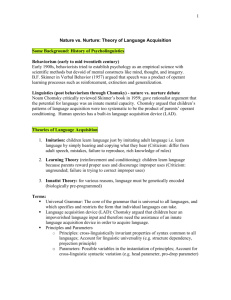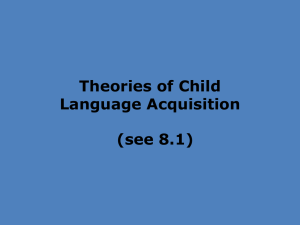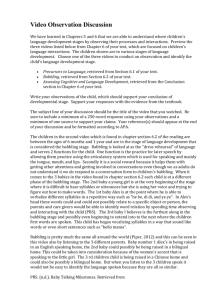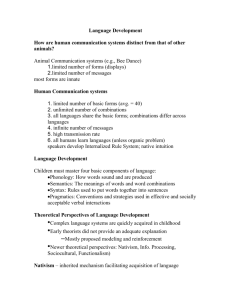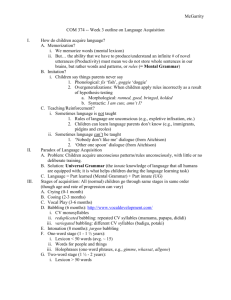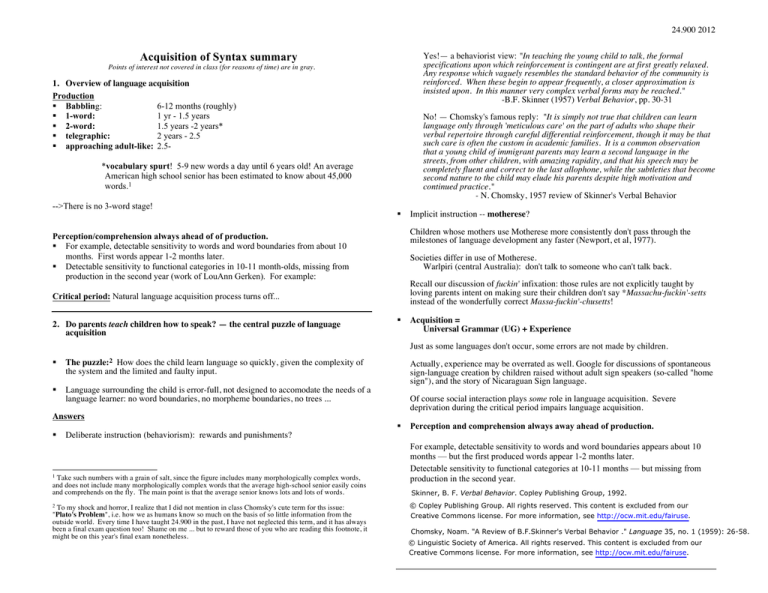
24.900 2012
$FTXLVLWLRQRI6\QWD[VXPPDU\
Yes!— a behaviorist view: "In teaching the young child to talk, the formal
specifications upon which reinforcement is contingent are at first greatly relaxed.
Any response which vaguely resembles the standard behavior of the community is
reinforced. When these begin to appear frequently, a closer approximation is
insisted upon. In this manner very complex verbal forms may be reached."
-B.F. Skinner (1957) Verbal Behavior, pp. 30-31
Points of interest not covered in class (for reasons of time) are in gray.
1. Overview of language acquisition
Production
§ Babbling:
6-12 months (roughly)
§ 1-word:
1 yr - 1.5 years
§ 2-word:
1.5 years -2 years*
§ telegraphic:
2 years - 2.5
§ approaching adult-like: 2.5-
No! — Chomsky's famous reply: "It is simply not true that children can learn
language only through 'meticulous care' on the part of adults who shape their
verbal repertoire through careful differential reinforcement, though it may be that
such care is often the custom in academic families. It is a common observation
that a young child of immigrant parents may learn a second language in the
streets, from other children, with amazing rapidity, and that his speech may be
completely fluent and correct to the last allophone, while the subtleties that become
second nature to the child may elude his parents despite high motivation and
continued practice."
- N. Chomsky, 1957 review of Skinner's Verbal Behavior
*vocabulary spurt! 5-9 new words a day until 6 years old! An average
American high school senior has been estimated to know about 45,000
words.1
-->There is no 3-word stage!
§
Children whose mothers use Motherese more consistently don't pass through the
milestones of language development any faster (Newport, et al, 1977).
Perception/comprehension always ahead of of production.
§ For example, detectable sensitivity to words and word boundaries from about 10
months. First words appear 1-2 months later.
§ Detectable sensitivity to functional categories in 10-11 month-olds, missing from
production in the second year (work of LouAnn Gerken). For example:
Societies differ in use of Motherese.
Warlpiri (central Australia): don't talk to someone who can't talk back.
Recall our discussion of fuckin' infixation: those rules are not explicitly taught by
loving parents intent on making sure their children don't say *Massachu-fuckin'-setts
instead of the wonderfully correct Massa-fuckin'-chusetts!
Critical period: Natural language acquisition process turns off...
2. Do parents teach children how to speak? — the central puzzle of language
acquisition
Implicit instruction -- motherese?
§
Acquisition =
Universal Grammar (UG) + Experience
Just as some languages don't occur, some errors are not made by children.
§
The
How does the child learn language so quickly, given the complexity of
the system and the limited and faulty input.
§
Language surrounding the child is error-full, not designed to accomodate the needs of a
language learner: no word boundaries, no morpheme boundaries, no trees ...
puzzle:2
Actually, experience may be overrated as well. Google for discussions of spontaneous
sign-language creation by children raised without adult sign speakers (so-called "home
sign"), and the story of Nicaraguan Sign language.
Of course social interaction plays some role in language acquisition. Severe
deprivation during the critical period impairs language acquisition.
Answers
§
§
1 Take such numbers with a grain of salt, since the figure includes many morphologically complex words,
and does not include many morphologically complex words that the average high-school senior easily coins
and comprehends on the fly. The main point is that the average senior knows lots and lots of words.
2
Perception and comprehension always away ahead of production.
Deliberate instruction (behaviorism): rewards and punishments?
To my shock and horror, I realize that I did not mention in class Chomsky's cute term for ths issue:
"Plato's Problem", i.e. how we as humans know so much on the basis of so little information from the
outside world. Every time I have taught 24.900 in the past, I have not neglected this term, and it has always
been a final exam question too! Shame on me ... but to reward those of you who are reading this footnote, it
might be on this year's final exam nonetheless.
For example, detectable sensitivity to words and word boundaries appears about 10
months — but the first produced words appear 1-2 months later.
Detectable sensitivity to functional categories at 10-11 months — but missing from
production in the second year.
Skinner, B. F. Verbal Behavior. Copley Publishing Group, 1992.
© Copley Publishing Group. All rights reserved. This content is excluded from our
Creative Commons license. For more information, see http://ocw.mit.edu/fairuse.
Chomsky, Noam. "A Review of B.F.Skinner's Verbal Behavior ." Language 35, no. 1 (1959): 26-58.
© Linguistic Society of America. All rights reserved. This content is excluded from our
Creative Commons license. For more information, see http://ocw.mit.edu/fairuse.
-23. Phonetics
§
§
§
Discussed earlier in the course. Infants discriminate the sounds of speech categorially,
in an adult-like manner, even when the distinctions lie at arbitrary points along an
acoustic continuum.
Distinctions not used in the target language are lost (more accurately: suppressed in
some fashion) during the first year of life. See below.
4. Phonology
Child's tasks:
§ determine the phonemic inventory (underlying segments) of the language
§ build the phonological part of the lexicon (underlying representations)
§ determine the rule system that relates underlying representations to surface forms
Determining phonemic inventory
Production:
4-5 months, some speech sounds.
6-7 months - "canonical babbling" begins.
Babbling initially contains a wide repertory of speech sounds, and finally zeroes in on the
speech sounds of the target language.
§
Around 8-10 months, adults can recognize the target language of a babbling child
(French, Cantonese, Arabic). By 6 months, Chinese children's babbling contains more
tonal variation than the babbling of an American child.
§
Deaf children babble vocally as well, though naturally there's no gradual
approximation to a target language.
§
Also: gestures analogous to babbling are noted in deaf children learning ASL.
Conclusion: inner biological clock governs onset of babbling; this clock is unaware of
child's deafness.
§
Just as spoken language babbling shows properties of the language being acquired, so
does sign language babbling.
Laura Pettito's work: Hearing children who are acquiring sign (deaf parents) babble
manually. You can see the video clip from class, along with a fuller description of this
work, at http://petitto.gallaudet.edu/%7Epetitto/archive/nature.html. The other
materials on Pettito's website are worth reading as well.
Children with tracheostomy surgery that eliminates vocal production do not hear
themselves babble. When the tracheostomy hole is closed, there are some delays in
speech, but they quickly jump to age-appropriate behavior, skipping various stages.
Conclusion: Babbling is linguistic (not motoric) — but it is not "practice" essential
for language acquisition. It is a by-product of the process of language acquisition, not
an essential building block.
Perception: During first year, child stops discriminating certain distinctions that are
non-phonemic in his/her target language. This parallels the refinement of
sounds produced in babbling that approximates the target language.
§
First words/Production: Not all contrasts made, much individual variation in order
with which contrasts appear in production (e.g. alveolar/velar then labial).
For example, a typical development of contrasts:
stage 1: p t-k
stage 2: p t k
stage 3: voicing
stage 4: nasal
Perception/knowledge lags behind production:
§
Children know the contrasts that they do not produce/
§
Also, numerous observations that children do not recognize words produced with
the very phonetic changes they put in them. A child who says sip for ship will not
identify a sip as something you sail in.
-3Prosodic bootstrapping:
Some common, but not universal phonological phenomena respect word boundaries.
Underlying representations/rule system
(1) A Japanese child's phonology
Age 3;2: substitutes [t] for [k] — but phonological rules that apply to adult [t] only
apply to those [t]'s that really are [t]'s for the adult.
child
mitaŋ
potetto
neto
tama
terebi
tobɯ
matʃi
tsɯta
adult
mikan
poketto
neko
tama
terebi
tobɯ
matʃi
tsɯta
comment adult [k]->child [t]
adult [t] stays [t]
t→tʃ /__i
t→ts/__ɯ
meaning
'orange'
'pocket'
'cat'
'ball'
'TV'
'fly'
'city'
'ivy'
§
For example, in French, the final a of panorama is longer than the first a of
matimaticien. 3-day old infants can distinguish ma-ti from panorama typique from
ma-ti out of matematricien. So the information, if relevant to guessing word
boundaries, is perceived... [Mehler et al -- this is a sucking/habituation experiment]
§
Also, typical stress patterns get noticed. Czech - initial / French - final / Polish penultimate. English: 90% of nouns have stressed initial syllables. If a child
anticipates this sort of regularity, it at least narrows hypotheses... In a 1993 study
by Juszyk, Cutler and Redanz, 9-month old American infants listened longer to
words with initial stress than to other words. No such difference among 6-month
olds.
§
Maybe these features are exaggerated in production by parents (motherese)?
Statistical bootstrapping
These rules do not apply to child's [t] that corresponds to adult [k]:
ati
tɯma
aki
kɯma
'fall'
'bear'
But production differences are systematic and linguistic:
For example, common to use only initial onset and rhyme of adult production. This
creates syllable simplification in monosyllabic words: (bɛd → bɛ). But this simplified
syllable is copied (reduplication) in production of a disyllabic word: chicken → [dɪdɪ],
water →[wɑwɑ]. The syllable count of the word is preserved, with a morphological
process known in the adult grammar (reduplication) used to create the second syllable.
5. Lexicon
Discerning word-boundaries:
Kids already know more than they say. Work of (the late) Peter Jucszyk and others:
• In 11-month old, selective looking reveals preference for pauses that coincide
with word boundaries over pauses inserted between syllables of words.
• In 9-month old, no preference.
So what happens between 9 and 11? A bootstrapping problem.
How do you segment speech into words if you don't know the words?
No magic bullet, it seems!
two possibilities:
Sequences of syllables that overlap word boundaries are often less likely than sequences of
syllables within words, simply because it's words that are being learned.
• pretty baby: [tibej] (pret-ty ba-by) less common because it's not a word. If kids
are sensitive to these probabilities, they can form hypotheses about word/nonword on the basis of these probabilities.
• Computer corpus analysis does fairly well (emphasize "fairly") finding word
boundaries this way. Do babies do this too? Perhaps.
6. Morphology
Child's tasks:
§ determine the morphemes/words of the language
§ determine the rules that combine morphemes into words
Example:
learn that walked contains two morphemes
On the one hand...
§ Some evidence that language acquisition device is "pretuned" to pick up
morphological patterns.
Those of you who read the paper by Safran, Aslin & Newport on statistical
learning by infants (one of the choices for the first paper) might be interested in
a follow-up by Marcus et al (1999) in Science:
In a clever twist on the Saffran et al. experiment, Gary Marcus of NYU and three colleagues
did a similar experiment with 7-month old (actually, slightly younger) infants. (Science,
January 1, 1999). Once again, a two-minute stream of synthesized speech was played to the
infants. Once again, the speech stream was composed of three-syllable nonsense words, made
from synthesized speech, with no cues identifying the word boundaries. Once again, the
-4children were played different recordings in a later presentation which they could control by
gazing at or looking away from a blinking light.
glasses
wugs
luns
tors
heafs
eras
tasses
gutches
kazhes
nizzes
This time, however, the nonsense words in the first presentation were not randomly chosen
sequences of syllables, but conformed to simple rules, or templates. One group of infants, for
example, heard a string of nonsense words in which the second two syllables were identical (ga
ti ti, li na na). Another group heard words in which the first and third syllables were identical
(ti ga ti, na li na).
The key recording in the second presentation did not consist this time of the same words
rearranged, but consisted of entirely new words that followed the same rule as the first set of
words. Could infants distinguish new words that followed the rule from new words that did
not? Strikingly, they could. The infants preferred novel second presentations over familiar
second presentations. But "familiar" here meant -- not containing the same "words" -- but
containing new words that followed the old rule. In their words: "Infants [can] extract abstract
algebra-like rules that represent relationships between placeholders (variables), such as “the
first item X is the same as the third item Y,” or more generally, that “item I is the same as item
J...In addition to having the capacity to represent such rules, our results appear to show that
infants have the ability to extract those rules rapidly from small amounts of input and to
generalize those rules to novel instances."
On the other hand...
§ Morphological rule learning across the entire language takes a while longer.
It's still miraculously fast, but far from instantaneous!
Classic experiment: the "wug test". At what age do English-speaking children
produce the correct plural endings [-s], [-z] and [-əәz]? Answer: quite early for
[-s] (cats), and [-z] (dogs), but quite late for the [-əәz] that follows sibilants
(horses, edges). Testing is done with a mixture of nouns that the children know
and invented nouns like the now-famous wug:
% correct pre-school answers % correct first- grade answers
75
99
76
97
68
92
73
90
79
80
58
86
28
39
28
38
25
36
14
33
Note about 2/3 of the first-graders tested failed to produce adult-like plurals for words that
end in sibilants. That is very late by the standards of language acquisition experiments!
7. Syntax
(2)
What we find when we carefully study the world's languages
Languages are not all the same, but the ways in which they differ are highly
restricted. The same peculiar bits show up again and again, all over the world.
What's the same is called Universal Grammar (UG)
What's different are settings of parameters within UG.
An acquisition perspective on UG and parameter setting:
• UG reflects our genetic endowment for language
• Parameter setting reflects our linguistic experience in early childhood.
•
This is a Wug.
(3)
•
Now there is another one.
There are two of them.
There are two
.
Image by MIT OpenCourseWare.
For example, though we don't find verb-second in all the languages of the world,
we do find it popping up repeatedly — as discussed in the syntax lecture notes. On
the other hand (I am repeating myself here) there are some types of languages that are
just as easy to describe in words as the verb-second languages, which we never find:
Some languages that don't exist anywhere (as far as we know):
a. Like German, but patterns of embedded and main clause are reversed.
b. Main verb must follow the second phrase, third phrase, etc.
c. Not the main verb, but the direct object must follow the first phrase.
We made a similar point in class when we discussed the relative ordering of heads of
phrases and their complements. We observed that the relative order of a head and the
element that it merges with varies systematically across languages.
We also observed that postulating a uniform "head-first/head-last" parameter across
-5entire languages oversimplifies the picture. Certain kinds of mixed languages do exist,
but they are restricted by FOFC (the Final-over-Final Constraint). If correct, FOFC is
(or is a by-product of) a principle of UG — a principle that restricts the ways in
which languages vary (and restricts the "search space" for a child acquiring
language).
Some other parameters (and how they are set in a few languages)
[See Baker's book for much more,]
1. Subject pro-drop
(4) Italian: +
a. Io parlo italiano
(I) speak Italian
b. Noi parliamo italiano
(we) speak Italian
(5)
(6)
Chinese: +
Ta kanjian ta le.
(he) see
he LE
'He saw him'.
English: *(We) speak English.
2. Object pro-drop
(7) Chinese: +
Ta kanjian ta
le.
he see
(him) LE
(8) Italian: *Gianni lo
vede.
Gianni (him) sees.
(11) Mohawk: [+ incorporation intoV]
Owira'a waha'-wahrake'.
baby
meat-ate
(Baker p. 91)
Mohawk:
polysynthesis (V):
subject pro-drop:
object pro-drop:
+
+
+
("incorporation")
(12) a. Wa'eksohare'
'She dishwashed'
b. Wa'kenaktahninu'
'I bed-bought.'
c. Wahana'tarakwetare'
'He bread-cut.'
English:
polysynthesis (V):
subject pro-drop:
object pro-drop:
—
—
—
(13) The verb-object constraint
The object of a verb must be the first noun (phrase) to combine with the verb; the
subject cannot combine with the verb until after the object does.
(14) ...in English compounding
a. I disapprove of meat eating in here. (i.e. meat getting eaten)
b. *I disapprove of baby eating in here. (i.e. babies eating dinner)
(15) ...in Mohawk "incorporation"
*Wahawirake' ne o'wahru.
the meat
baby-ate
'The baby ate the meat.'
(compare (11)
(Object pronouns generally move to the left of I in Italian.)
An acquisition perspective on parameter-setting
(9) English: *John saw him.
• Early production of complete sentences may show parameters set in a fashion familiar
from languages other than the language that the child is in the process of acquiring.
3. Polysynthesis
(10) English: [+ incorporation into N] (and A), but [- incorporation into V]
a, I disapprove of book-burning
b. A user-friendly computer is a distant goal.
c. *The baby meat-ate last night.
Example: pro-drop
Danish, English and French are not pro-drop languages, but early sentence production
appears to show selective omission of subject pronouns:
-6(16) Early pro-drop
a. Danish
Se, blomster har.
look flowers have/has
b. English
Tickles me.
c. French
Mange du pain.
eat-3sg some bread
(18)
(Jens, 2;2)
b. Dutch
Earst kleine boekje lezen.
first little book read-INFIN
'First (I/we) read little book'
(Adam, 3;6)
c. French
Dormir petit bébé.
sleep-INFIN little baby
'Little baby is sleeping.'
Alas, we did not have time for the following discussion, but you may find the topic
interesting nonetheless:
Italian kids drop subject pronouns much more often than their English-speaking
counterparts. So English pro-drop can't just be "English-speaking children
speaking Italian". There must be a different factor. Possibility: maturation.
Root infinitive stage: Speakers of many languages go through a period in which
they use infinitival verbs in main clauses, and these may lack subjects,
(17) a. Michel dormir.
b. Ik ook lezen.
(Hein, 2;6)
(French: 'Michel sleep-infin,')
(Dutch: 'I also read-infin.')
(Daniel, 1; 11)
English does not have a specifically infinitive suffix, but the root infinitive state is
found among English-speaking children as well — showing up as missing -s on
third-person present-tense verbs. This is not an inability to pronounce the -s, since
plural and possessive -s is regularly present (with the caveat discussed above in
connection with the wug discussion):
We also saw a video of English-speaking kids "speaking German" or "speaking
Swedish" with respect to other phenomena, making the same points.
§
(Jens, 2;0)
(Grégoire, 2;1)
Are young English-speaking children in effect "speaking Italian" until they start
regularly using subject pronouns? Much controversy ...
§
Optional root infinitive stage
a. Danish
Hun sove.
she sleep-INFIN
(19) English root infinitives
a. Papa have it. (Eve, 1;6)
b. Cromer wear glasses. (Eve, 2;0)
c. Marie go. (Sarah, 2;3)
d. Mumma ride horsie. (Sarah, 2;6)
§
It has been claimed that "early pro-drop" in languages like Dutch or English is
largely limited to such root infinitival clauses. Hmm... So is it pro-drop after all.
And if so ...
So what about parameter setting? When does it happen?
Answer: Perhaps some syntactic parameters are set earlier than we can yet detect.
For example, German children around age 2 already know V2 — and even
though they use root infinitives, they almost never apply V/2 to them.
In adult German, an infinitive verb does not move to C, but remains final in VP:
(20) German (adult) infinitival verb does not move to C
Ich will [dieses Buch lesen]
I want this
book read-INFIN
'I want to read this book'
Here are some examples of sentences uttered by the German speaking child
Andreas (2;1). The first two examples show finite (non-infinitive) verbs, while the
second two show root infinitives:
-7(21)
Andreas (2;1): finite and infinitive root sentence
a. Ich hab ein dossen Ball.
I have a big
ball
(note: dossen for grossen)
b. Ich mach das nich.
I do that not
'I'm not doing that.'
c. Thorsten Caesar haben.
Thorsten Caesar have-INFIN
(note: Caesar = a doll)
d. Du das haben.
you that have-INFIN
• In fact, out of 281 sentences in a corpus of Andreas's utterances on a single day, which
included 231 finite sentences and 51 sentences with root infinitives, Andreas
overwhelmingly applied V2 to the finite verbs and failed to apply it to the non-finite
verbs — following the adult rule in this respect. (He disobeys the adult rules of V2
7.8% of the time. Child data is always noisy.)
+Finite -Finite
Verb second 216
7
Verb final
15
44
• Some example of Andreas' finite sentences with V2:
(22)
Direct object topicalization
a. Kahehabahn fahr ich.
toy-race-car drive I
b. Eine Fase hab ich.
a
vase have I
(23)
Adverb topicalization
a. Da bin ich.
there am I
b. So macht der.
so does he
MIT OpenCourseWare
http://ocw.mit.edu
24.900 Introduction to Linguistics
Fall 2012
For information about citing these materials or our Terms of Use, visit: http://ocw.mit.edu/terms.

